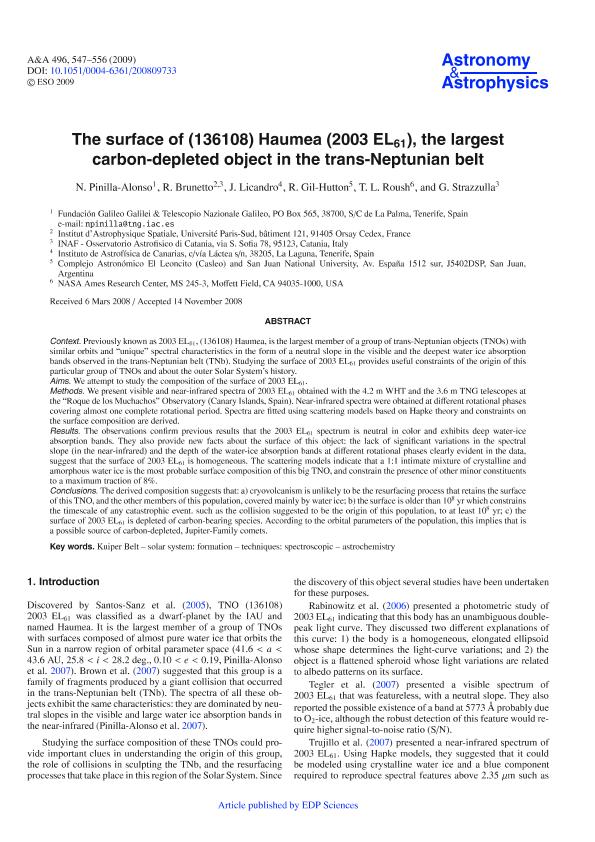Artículo
Study of the surface of (136108) Haumea (2003 EL61), the largest carbon-depleted object in the trans-neptunian belt
Pinilla Alonso, N.; Brunetto, R.; Licandro, J.; Gil Hutton, Ricardo Alfredo ; Roush, T.L.; Strazzulla, G.
; Roush, T.L.; Strazzulla, G.
 ; Roush, T.L.; Strazzulla, G.
; Roush, T.L.; Strazzulla, G.
Fecha de publicación:
03/2009
Editorial:
EDP Sciences
Revista:
Astronomy and Astrophysics
ISSN:
0004-6361
Idioma:
Inglés
Tipo de recurso:
Artículo publicado
Clasificación temática:
Resumen
Context Previously known as 2003 EL61, (136108) Haumea, is the largest member of a group of trans-Neptunian objects (TNOs) with similar orbits and "unique" spectral characteristics in the form of a neutral slope in the visible and the deepest water ice absorption bands observed in the trans-Neptunian belt (TNb). Studying the surface of 2003 EL61 provides useful constraints of the origin of this particular group of TNOs and about the outer Solar System's history. Alms. We attempt to study the composition of the surface of 2003 EL61. Methods. We present visible and near-infrared spectra of 2003 EL61 obtained with the 4.2 m. WHT and the 3.6 m TNG telescopes at the "Roque de los Muchachos" Observatory (Canary Islands, Spain). Near-infrared spectra were obtained at different rotational phases covering almost one complete rotational period. Spectra are fitted using scattering models based on Hapke theory and constraints on the surface composition are derived. Results. The observations confirm previous results that the 2003 EL61 spectrum is neutral in color and exhibits deep water-ice absorption bands. They also provide new facts about the surface of this object: the lack of significant variations in the spectral slope (in the near-infrared) and the depth of the water-ice absorption bands at different rotational phases clearly evident in the data, suggest that the surface of 2003 EL61 is homogeneous. The scattering models indicate that a 1:1 intimate mixture of crystalline and amorphous water ice is the most probable surface composition of this big TNO, and constrain the presence of other minor constituents to a maximum traction of 8%. Conclusions. The derived composition suggests that: a) cryovolcanism is unlikely to be the resurfacing process that retains the surface of this TNO, and the other members of this population, covered mainly by water ice; b) the surface is older than 10 8 yr which constrains the timescale of any catastrophic event, such as the collision suggested to be the origin of this population, to at least 108 yr; c) the surface of 2003 EL61 is depleted of carbon-bearing species. According to the orbital parameters of the population, this implies that is a possible source of carbon-depleted, Jupiter-Family comets.
Archivos asociados
Licencia
Identificadores
Colecciones
Articulos(CASLEO)
Articulos de COMPLEJO ASTRONOMICO "EL LEONCITO"
Articulos de COMPLEJO ASTRONOMICO "EL LEONCITO"
Citación
Pinilla Alonso, N.; Brunetto, R.; Licandro, J.; Gil Hutton, Ricardo Alfredo; Roush, T.L.; et al.; Study of the surface of (136108) Haumea (2003 EL61), the largest carbon-depleted object in the trans-neptunian belt; EDP Sciences; Astronomy and Astrophysics; 496; 2; 3-2009; 547-556
Compartir
Altmétricas



